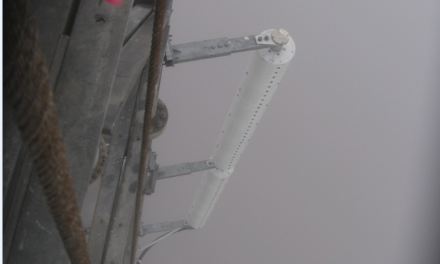Ever wonder what the big deal is with all the LTE or 4G upgrades? In the picture below (taken from a Homestead, FL tower that is 1,465′) is an example of a normal “old” style cell site. It shows a single sector of a macro cell site.
In the past, most macro sites were made of three sectors of three antennas each. In the picture, two-panel antennas are shown; these antennas are typically about 4′ tall, 10″ wide, and 3″ deep. Older antennas usually weigh 25 pounds or less.
The small box on the top pipe is a tower-mounted amplifier called a TMA. Notice the large, black, coaxial cables. In this simple style scenario, there is one main large feeder coaxial cable for each port or connection on the back of the antenna. Each antenna has two ports, so two main transmission cables per antenna, and one of those cables has a TMA inline.

Now check out the other photos, which show sites and equipment for a modern LTE upgraded site. There are larger antennas, up to 8′ tall and weighing in at 65+ pounds. Most newer antennas have 4 or more ports or connections, and we have seen them with as many as 10 connections or ports.
Instead of small TMA, there are remote radio heads that average 22″ x 18″ x 10″ and weigh 55 pounds. Hybrid cables are used either in place of coaxial cables or in addition to the coaxial cables. Hybrid cables have fiber optic strands in them as well as DC power wires. These hybrid cables need a junction box at the tower top to split out the hybrid fibers and DC power wires so those can be routed to different areas of the remote radio heads.
At the recent PCIA conference in May, I sat in on a seminar regarding the new LTE equipment, and one of the speakers said from an engineering perspective, 1G–2G equipment weighed 250 lbs. per sector; 4G LTE equipment weighs 750 lbs. per sector; and the 5G technology moving forward is or will weigh about 1500 lbs. per sector. The newer equipment is so heavy, and there is so much of it that the pipe mounts themselves have to be replaced on the tower because the existing pipe mounts can’t support the larger heavier equipment.









